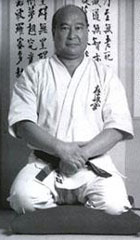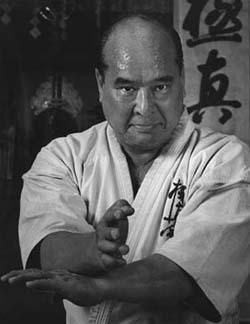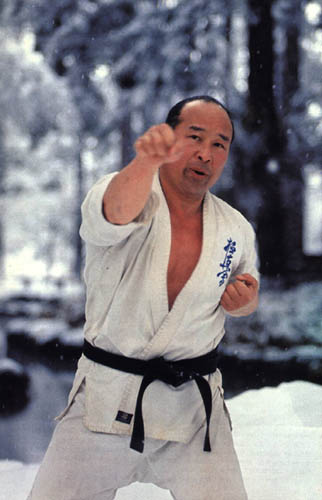


Sosai Masutatsu Oyama



was born in July 12, 1923 in Qa-Ryong-Ri Yong-chi-Myo'n Chul Na Do South Korea.
His child given name was Young-Li, but when he immigrated to Japan, they
pressured him to take a Japanese name. He chose Oyama which means "great
mountain". At a relatively young age he was sent to Manchuria, in Southern
China, to live on his sister's farm. At the age of nine, he started studying the
Southern Chinese form of Kempo called Eighteen Techniques (Shaku-riki system)
his teacher was Mr. Yi who was at the time working on his sister's farm. Mas
Oyama studied with Mr. Yi for about 2 years He attained the level of Shodan. At
the age of 12 he returned to Korea were he continued his training in Korean
martial art known as Taiken or Chabi. These Korean arts were a mixture of Kempo,
which was similar to kung fu, and Ju Jitsu. This training continued until about
the age of 13 years. At this point he was moved to Tokyo, Japan to train as an
aviator, to be like Bismarck, his hero of the time. He was enrolled at the
Yamanashi Youth Aviation Institute. Survival on his own at that age proved to be
more difficult than he thought, especially as a Korean in Japan, and the aviator
training fell by the wayside. During this time he started training in boxing and
Judo. One day he noticed some student training in Okinawa karate, he got
interested and went to train at the Dojo of Gichin Funakoshi at Takushoku
University, where he learned what is today known Shotokan Karate. His training
progress was very impressive, by the age of seventeen he was already a 2nd Dan,
by the age of 20, he was a 4th Dan. At this point he also took a serious
interest in judo, and his progress there was no less amazing. By the time he had
quit training in Judo, less than four years after he had started, he had
achieved the rank of fourth Dan in Judo.
At this time Mas Oyama entered the Butokukai which was the trained academy for
the imperial Japanese Military. The Butokakai specialized in guerrilla warfare,
espionage, and hand to hand combat. Sosai spent 2 years in this organization
which ended with the close of World War II. The defeat of Japan and the
subsequent indignity of Occupation was very hard to take by Mas Oyama. At this
time he decided to continue his training under the direction of Master So Nei
Chu, also a Korean (from Oyama's own province) living in Japan was a Goju expert
and student of Chojun Miyagi, the founder of Goju Karate. So Nei Chu renowned
for his physical and spiritual strength, was purported to be the leading expert
of Goju Karate in Japan at the time, next to Miyagi Sensei. It was Master So who
encouraged Sosai Oyama to undertake his mountain retreat to strengthen his
technical skills and temper his spirit. He was accompanied by one of his own
students, but after six months of isolation, the student secretly fled during
the night leaving Mas Oyama to continue his vigorous training alone which became
even harder for Oyama, who wanted more than ever to return to civilization. So
Nei Chu wrote to him that he should shave off an eyebrow in order to get rid of
the urge. Surely he wouldn't want anyone to see him that way! This and other
more moving words convinced Oyama to continue, and he resolved to become the
most powerful karate man in Japan. Soon however, his sponsor informed him that
he was no longer able to support him and so after 14 months, he had to end his
solitude. A few months later in 1947, after returning to civilization, he tested
his abilities in the Karate division of the first Japanese National Martial Arts
Championships, which he won. However, he felt empty for not having complete the
3 years of solitude. He then decided to dedicate his life completely to
karate-do, so he started again this time on mount Kiyozumi also in Chiba
Prefecture. He chose this site for its spiritual uplifting environment.
This time his training was fanatical - 12 hours a day every day with no rest
days, standing under (cold) buffeting waterfalls, breaking river stones with his
hands, using trees as Makiwara, jumping over rapidly growing flax plants
hundreds of times each day. Each day also included a period of study of the
ancients classics on the Martial arts Zen, and philosophy.
After eighteen months he came down fully confident of himself, and able to take
control of his life. Never again would he be so heavily influenced by his
society around him. (Though it is probably safe to say that his circumstances
were also probably never again as traumatic!)
In 1950, Sosai (the founder) Mas Oyama started testing (and demonstrating) his
power by fighting bulls. In all, he fought 52 bulls, three of which were killed
instantly, and 49 had their horns taken off with knife hand blows. That it is
not to say that it was all that easy for him. Oyama was fond of remembering that
his first attempt just resulted in an angry bull. In 1957, at the age of 34, he
was nearly killed in Mexico when a bull got some of his own back and gored him.
Oyama somehow managed to pull the bull off and break off his horn. He was
bedridden for 6 months while he recovered from the usually fatal wound. Today of
course, the animal rights groups would have something to say about these
demonstrations, despite the fact that the animals were already all destined for
slaughter. In 1952, he traveled the United States for a year, demonstrating his
karate, live and on national television. During subsequent years, he took on all
challengers, resulting in fights with 270 different people. The vast majority of
these were defeated with one punch! A fight never lasted more than three
minutes, and most rarely lasted more than a few seconds. His fighting principle
was simple if he got through to you, that was it. If he hit you, you broke. If
you blocked a rib punch, you arm was broken or dislocated. If you didn't block,
your rib was broken. He became known as the Godhand, a living manifestation of
the Japanese warriors' maxim Ichi geki, Hissatsu or "One strike, certain death".
To him, this was the true aim of technique in karate. The fancy footwork and
intricate techniques were secondary (though he was also known for the power of
his head kicks). It was during one of his visits to the United States that Mas
Oyama met Jacques Sandulescu, a big (190 cm and 190 kg of muscle) Romanian who
had been taken prisoner by the Red Army at the age of 16, and sent to the coal
mines as a slave laborer for two years. They quickly became friends and remained
so for the rest of Oyama's life, and Jacques still trains and acts as advisor to
the IKO(1) to this day. In 1953, Mas Oyama opened his first "Dojo", a grass lot
in Mejiro in Tokyo. In 1956, the first real Dojo was opened in a former ballet
studio behind Rikkyo University, 500 meters from the location of the current
Japanese Honbu Dojo (headquarters). By 1957 there were 700 members, despite the
high drop-out rate due to the hardness of training. Practitioners of other
styles came to train here too, for the jis-sen kumite (full contact fighting).
One of the original instructors, Kenji Kato, has said that they would observe
those from other styles, and adopt any techniques that "would be good in a real
fight". This was how Mas Oyama's karate evolved. He took techniques from all
martial arts, and did not restrict himself to karate alone. The Oyama Dojo
members took their Kumite seriously, seeing it primarily as a fighting art, so
they expected to hit and to be hit. With few restrictions, attacking the head
was common, usually with the palm heel or towel-wrapped knuckles. Grabs, throws,
and groin attacks were also common. Kumite rounds would continue till one person
loudly conceded defeat. Injuries occurred on a daily basis and the drop out rate
was high (over 90%). They had no official do-gi and wore whatever they had.
In 1952, Mas Oyama gave a demonstration in Hawaii. A young Bobby Lowe saw him
and was stunned by the power Oyama demonstrated. It was not as though Bobby Lowe
was inexperienced in martial arts. Though still quite young, his achievements to
date were not much less than those of Mas Oyama himself. His father had been a
Kung Fu instructor, and he had participated in any fighting art he could find.
By the age of 23, he was Yondan in judo, Nidan in Kempo, Shodan in Aikido, and a
highly regarded welterweight boxer. It was not long before Bobby Lowe became the
first Kyokushin uchi deshi or "live-in student" of Mas Oyama's. He trained daily
with Mas Oyama for one and a half years. Eventually, an uchi deshi's time became
"1000 days for the beginning". These uchi deshi became known as Wakajishi, or
the "Young Lions" of Mas Oyama and only a few of the hundreds of applicants were
chosen each year for the privilege of training full time under the Master. In
1957, Bobby Lowe returned to Hawaii to open the first School of Oyama outside
Japan.
The beginning of Kyokushin: The current World Headquarters were officially
opened in June 1964, where the name Kyokushin, meaning "Ultimate truth" was
adopted. From then, Kyokushin continued to spread to more than 120 countries,
and registered members exceed 10 million making it one of the largest martial
arts organizations in the world. Among the better known Kyokushin Yudansha
(black belts) are Sean Connery (Honorary Shodan), Dolph Lundgren (Sandan, and
former Australian heavyweight champion. Famous movie star). Also some adepts
claim that Nelson Mandela, the President of South Africa, has an honorary 8th
Dan, given by the kyokushin Organization on June 01, 1995. However they fail to
mention that Nelson Mandela never accept this Belt, many believe that the reason
for this is because Kyokushin in South Africa support the Apartheid Regime.
Sadly, Sosai Masutatsu Oyama died of lung cancer (as a non-smoker), at the age
of 70 in April 1994.